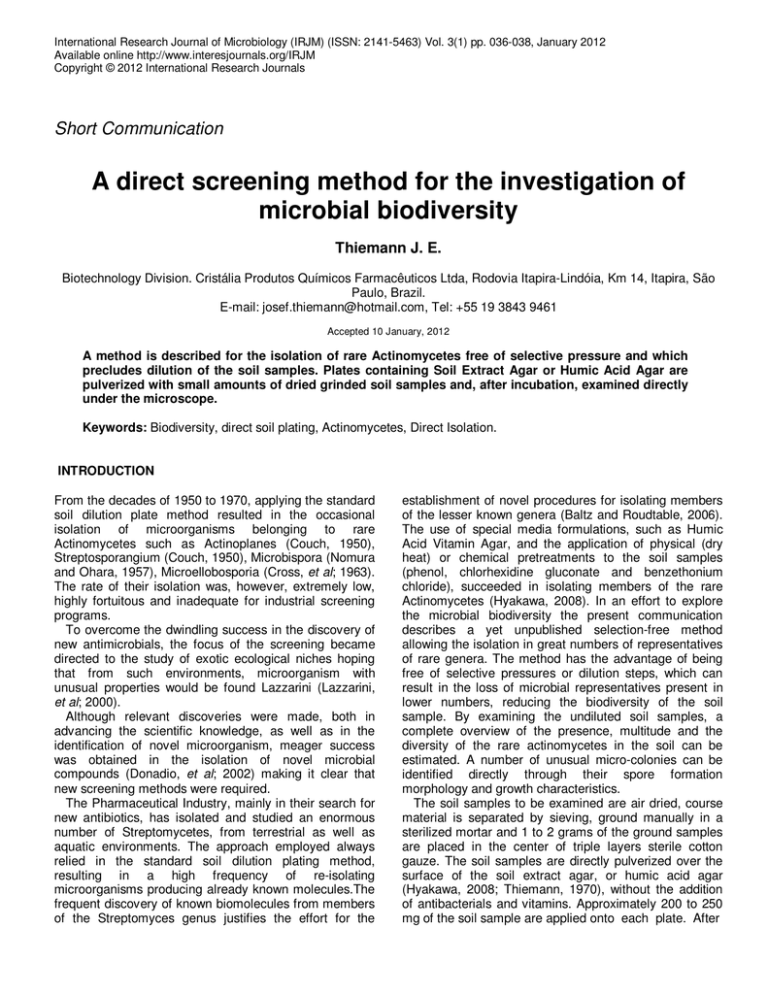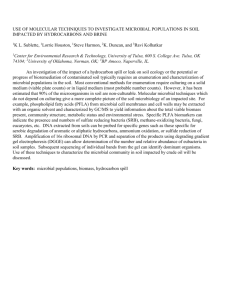Document 14104817
advertisement

International Research Journal of Microbiology (IRJM) (ISSN: 2141-5463) Vol. 3(1) pp. 036-038, January 2012 Available online http://www.interesjournals.org/IRJM Copyright © 2012 International Research Journals Short Communication A direct screening method for the investigation of microbial biodiversity Thiemann J. E. Biotechnology Division. Cristália Produtos Químicos Farmacêuticos Ltda, Rodovia Itapira-Lindóia, Km 14, Itapira, São Paulo, Brazil. E-mail: josef.thiemann@hotmail.com, Tel: +55 19 3843 9461 Accepted 10 January, 2012 A method is described for the isolation of rare Actinomycetes free of selective pressure and which precludes dilution of the soil samples. Plates containing Soil Extract Agar or Humic Acid Agar are pulverized with small amounts of dried grinded soil samples and, after incubation, examined directly under the microscope. Keywords: Biodiversity, direct soil plating, Actinomycetes, Direct Isolation. INTRODUCTION From the decades of 1950 to 1970, applying the standard soil dilution plate method resulted in the occasional isolation of microorganisms belonging to rare Actinomycetes such as Actinoplanes (Couch, 1950), Streptosporangium (Couch, 1950), Microbispora (Nomura and Ohara, 1957), Microellobosporia (Cross, et al; 1963). The rate of their isolation was, however, extremely low, highly fortuitous and inadequate for industrial screening programs. To overcome the dwindling success in the discovery of new antimicrobials, the focus of the screening became directed to the study of exotic ecological niches hoping that from such environments, microorganism with unusual properties would be found Lazzarini (Lazzarini, et al; 2000). Although relevant discoveries were made, both in advancing the scientific knowledge, as well as in the identification of novel microorganism, meager success was obtained in the isolation of novel microbial compounds (Donadio, et al; 2002) making it clear that new screening methods were required. The Pharmaceutical Industry, mainly in their search for new antibiotics, has isolated and studied an enormous number of Streptomycetes, from terrestrial as well as aquatic environments. The approach employed always relied in the standard soil dilution plating method, resulting in a high frequency of re-isolating microorganisms producing already known molecules.The frequent discovery of known biomolecules from members of the Streptomyces genus justifies the effort for the establishment of novel procedures for isolating members of the lesser known genera (Baltz and Roudtable, 2006). The use of special media formulations, such as Humic Acid Vitamin Agar, and the application of physical (dry heat) or chemical pretreatments to the soil samples (phenol, chlorhexidine gluconate and benzethonium chloride), succeeded in isolating members of the rare Actinomycetes (Hyakawa, 2008). In an effort to explore the microbial biodiversity the present communication describes a yet unpublished selection-free method allowing the isolation in great numbers of representatives of rare genera. The method has the advantage of being free of selective pressures or dilution steps, which can result in the loss of microbial representatives present in lower numbers, reducing the biodiversity of the soil sample. By examining the undiluted soil samples, a complete overview of the presence, multitude and the diversity of the rare actinomycetes in the soil can be estimated. A number of unusual micro-colonies can be identified directly through their spore formation morphology and growth characteristics. The soil samples to be examined are air dried, course material is separated by sieving, ground manually in a sterilized mortar and 1 to 2 grams of the ground samples are placed in the center of triple layers sterile cotton gauze. The soil samples are directly pulverized over the surface of the soil extract agar, or humic acid agar (Hyakawa, 2008; Thiemann, 1970), without the addition of antibacterials and vitamins. Approximately 200 to 250 mg of the soil sample are applied onto each plate. After Thiemann 037 Figure 1. A. Process of isolating fragments of Streptosporangium colony attached to the tip of the micromanipulator needle. B. Overgrowth of a microcolony of Actinoplanes by Streptomyces mycelium. C. Micro-colony of Microtetraspora sp. D. Micro-colony of Actinoplanes sp. E. Micro-colony of Dactylosporangium sp. F. Micro-colony of Streptosporangium sp. G. Example of a “Star shaped” colony morphology of an unclassified microorganism. H. Possible colony of Saccharomonospora sp. is indicated by the arrow. I. Microtetraspora sp with aerial mycelium. J. Novel Streptosporangium with large dark colored sporangia on aerial mycelium. K. Possible Mini Streptosporangium. L. Micro-colony of Micromonospora sp. incubation at room temperature for 3 to 4 weeks the plates are examined directly under the microscope, using a 20 X objective or a 50 X long distance objective. RESULTS AND DISCUSSION For the isolation of selected micro-colonies a micromanipulator (Fonbrune pneumatic Micromanipulator) was used. Glass needles prepared with the micro-forge were used for picking-up the selected colonies, mycelium fragments or spore chains adhering and were transferred to plates of the same media (Figure 1A). A total of ten colony fragments were normally transferred to a single plate, constituting the primary isolation plate. These plates were maintained at room temperature, in the dark, and the resulting colonies used for preparation of additional plates for purification and determination of their preliminary taxonomic standing, based mainly on the spore formation morphology, presence or absence of aerial mycelium, motile or non motile spores. For final maintenance, the isolates were kept as cryogenic suspensions at –70° C, as well as on Oat Meal Agar slants (Shirling and Gottlieb, 1966). The efficiency of the present screening method for the isolation of rare Actinomycetes has been corroborated by the number of novel species and genera isolated. Quite often interesting colonies are completely enmeshed and overgrown by streptomyces mycelium, rendering their isolation more difficult (Figure 1B), requiring the careful removal of the undesirable over-growth. Actinomycetes with aerial mycelium, such as Microbispora, Microtetraspora, or Streptosporangium (Figures 1C and 1F) do not present difficulty for their isolation compared to colonies devoid of aerial mycelium, as for instance Actinoplasnes or Dactylosporangium (Figures 1D and 1E), 038 Int. Res. J. Microbiol. and colonies forming spores only on the substrate mycelium. With these latter colonies, the careful removal of pieces of the agar containing the submerged sporulated mycelium proved to be successful. The major advantage of the present isolation technique resides in the fact, which cannot be overstressed, that the soil samples are examined in an undiluted and non selective state, greatly enhancing the possibility of isolating microorganisms present in low numbers. From a total of 29 different soil samples examined, the following numbers of representatives of rare genera were isolated: 63 Microtetraspora; 51 Streptosporangium; 27 Actinoplanes; 18 Dactylosporangium; 16 Nonomureae and 13 Microbispora. Beside these morphologically distinct genera, an additional 90 colonies with undefined taxonomic standing were also isolated. (Figures 1G to 1L). The difficulties inherent in the exploration of the microbial biodiversity to the discovery of novel natural products have several obstacles. However, the question that should be asked is not whether we should continue to screen the microbial biodiversity for New Chemical Entities (NCEs) with potential for drug development, but whether we can effort not to. At present, all antibiotics available are challenged by the appearance of resistant strains with very few alternatives available in the future. Directing the effort to the isolation of the lesser known genera will increase the chance of finding novel microorganisms capable of forming also potentially useful NCEs. ACKNOWLEDGMENTS The author is greatful to Dr. Lucidio C. Fardelone (Biotechnology Division, Cristália Produtos Químicos Farmacêuticos) and Dr. Otavio H. Thiemann (São Carlos Physics Institute, University of São Paulo) for assistance in manuscript preparation and photographic documentation, to Marina B. Riboldi, Rodrigo C.O. Bueno, and Eduardo P. Gottardo (Biotechnology Division, Cristália Produtos Químicos Farmacêuticos) for soil sample preparation, purification and preservation of the isolates. REFERENCES Baltz RH, Roundtable MF (2006). Is our antibiotic pipeline unproductive because of starvation, constipation or lack of inspiration? J. Ind. Microbiol. Biotech. 33:507-513. Couch JN (1950). Actinoplanes, a new genus of the Actinomycetales. J. Elisha Mitchell Sci. Soc. 6:87-92. Cross T, Lechevalier MP, Lechevalier H (1963). A new genus of the Actinomycetales: Microellobosporia, gen. nov. J.Gen. Microbiol. 31:421 – 429. Donadio S, Monciardini P, Alduina R, Mazza P, Chiochini C, Cavaletti L, Sosio M, Puglia AM (2002). Microbial technologies for the discovery of novel bio-active metabolites. J. Biotechnol. 99:187-198. Hyakawa M (2008). Studies on the isolation and distribuition of rare actinomycetes in soil. Actinomycetol. 22:12-19. Lazzarini A, Cavaletti L, Toppo G, Marinelli F (2000). Rare genera of actinomycetes as potential producers of new antibiotics. Antonie van Leeuwenhoek. 79:399-405. Nonomura H, Ohara Y (1957). Distribution of Actinomyces in the soil. Microbispora, a new genus of the Streptomycetaceae. J.Ferment. Technol. 35:307-311. Shirling EB, Gottlieb B (1966) Method for characterization of Streptomyces species. Int. J. Syst . Bacteriol. 16:313-340. Thiemann JE (1970). Study of some new genera and species of the Actinoplanaceae. In: The Actinomycetales. Ed. H. Prauser. ,pp 245257. Gustav Fischer Verlag, Jena.




